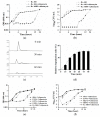CesH Represses Cereulide Synthesis as an Alpha/Beta Fold Hydrolase in Bacillus cereus
- PMID: 31010094
- PMCID: PMC6521208
- DOI: 10.3390/toxins11040231
CesH Represses Cereulide Synthesis as an Alpha/Beta Fold Hydrolase in Bacillus cereus
Abstract
Cereulide is notorious as a heat-stable emetic toxin produced by Bacillus cereus and glucose is supposed to be an ingredient supporting its formation. This study showed that glucose addition benefited on cell growth and the early transcription of genes involved in substrate accumulation and toxin synthesis, but it played a negative role in the final production of cereulide. Meanwhile, a lasting enhancement of cesH transcription was observed with the addition of glucose. Moreover, the cereulide production in ΔcesH was obviously higher than that in the wild type. This indicates that CesH has a repression effect on cereulide production. Bioinformatics analysis revealed that CesH was an alpha/beta hydrolase that probably associated with the cell membrane, which was verified by subcellular localization. The esterase activity against para-nitrophenyl acetate (PNPC2) of the recombinant CesH was confirmed. Although no sign of ester bond cleavage in cereulide or valinomycin was demonstrated in in vitro assays, CesH could reverse the cereulide analogue sensitivity of Bacillus subtilis in vivo, by which toxin degradation was facilitated. Moreover, site directed mutations identified that the conserved catalytic triad of CesH might consist of Serine 86, Glutamate 199, and Histidine 227. These results help us to understand the regulation of cereulide production and provide clues for developing control measurements.
Keywords: Bacillus cereus; alpha/beta hydrolase; cereulide; cesH.
Conflict of interest statement
The authors declare no conflict of interest.
Figures



Similar articles
-
The Food Poisoning Toxins of Bacillus cereus.Toxins (Basel). 2021 Jan 28;13(2):98. doi: 10.3390/toxins13020098. Toxins (Basel). 2021. PMID: 33525722 Free PMC article. Review.
-
Cereulide synthesis in emetic Bacillus cereus is controlled by the transition state regulator AbrB, but not by the virulence regulator PlcR.Microbiology (Reading). 2009 Mar;155(Pt 3):922-931. doi: 10.1099/mic.0.024125-0. Microbiology (Reading). 2009. PMID: 19246763
-
Identification of the main promoter directing cereulide biosynthesis in emetic Bacillus cereus and its application for real-time monitoring of ces gene expression in foods.Appl Environ Microbiol. 2010 Feb;76(4):1232-40. doi: 10.1128/AEM.02317-09. Epub 2009 Dec 28. Appl Environ Microbiol. 2010. PMID: 20038713 Free PMC article.
-
Inhibition of cereulide toxin synthesis by emetic Bacillus cereus via long-chain polyphosphates.Appl Environ Microbiol. 2011 Feb;77(4):1475-82. doi: 10.1128/AEM.02259-10. Epub 2010 Dec 17. Appl Environ Microbiol. 2011. PMID: 21169440 Free PMC article.
-
Why be serious about emetic Bacillus cereus: Cereulide production and industrial challenges.Food Microbiol. 2020 Feb;85:103279. doi: 10.1016/j.fm.2019.103279. Epub 2019 Jul 26. Food Microbiol. 2020. PMID: 31500702 Review.
Cited by
-
The Food Poisoning Toxins of Bacillus cereus.Toxins (Basel). 2021 Jan 28;13(2):98. doi: 10.3390/toxins13020098. Toxins (Basel). 2021. PMID: 33525722 Free PMC article. Review.
-
A Flagella Hook Coding Gene flgE Positively Affects Biofilm Formation and Cereulide Production in Emetic Bacillus cereus.Front Microbiol. 2022 Jun 10;13:897836. doi: 10.3389/fmicb.2022.897836. eCollection 2022. Front Microbiol. 2022. PMID: 35756067 Free PMC article.
-
Influence of the Phagemid PfNC7401 on Cereulide-Producing Bacillus cereus NC7401.Microorganisms. 2022 Apr 30;10(5):953. doi: 10.3390/microorganisms10050953. Microorganisms. 2022. PMID: 35630395 Free PMC article.
References
-
- Dommel M.K., Frenzel E., Strasser B., Blöchinger C., Scherer S., Ehling-Schulz M. Identification of the main promoter directing cereulide biosynthesis in emetic Bacillus cereus and its application for real-time monitoring of ces gene expression in foods. Appl. Environ. Microbiol. 2010;76:1232–1240. doi: 10.1128/AEM.02317-09. - DOI - PMC - PubMed
-
- Suwan S., Isobe M., Ohtani I., Agata N., Mori M., Ohta M. Structure of cereulide, a cyclic dodecadepsipeptide toxin from Bacillus cereus and studies on NMR characteristics of its alkali metal complexes including a conformational structure of the K+ complex. J. Chem. Soc. Perkin Trans. 1. 1995;1:765–775. doi: 10.1039/p19950000765. - DOI
-
- Hoornstra D., Andersson M.A., Teplova V.V., Mikkola R., Uotila L.M., Andersson L.C., Roivainen M., Gahmberg C.G., Salkinoja-Salonen M.S. Potato crop as a source of emetic Bacillus cereus and cereulide induced mammalian cell toxicity. Appl. Environ. Microbiol. 2013;79:3534–3543. doi: 10.1128/AEM.00201-13. - DOI - PMC - PubMed
Publication types
MeSH terms
Substances
LinkOut - more resources
Full Text Sources

